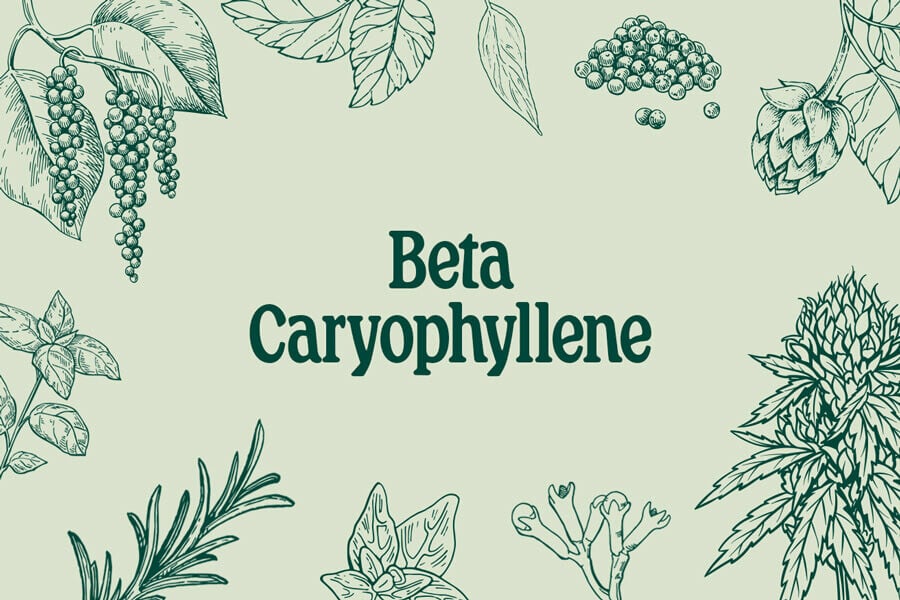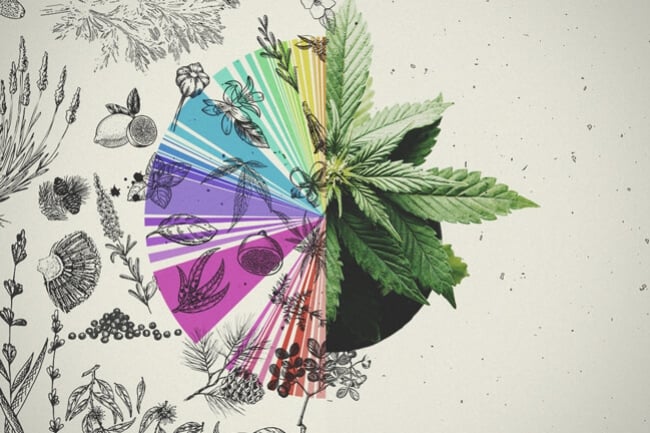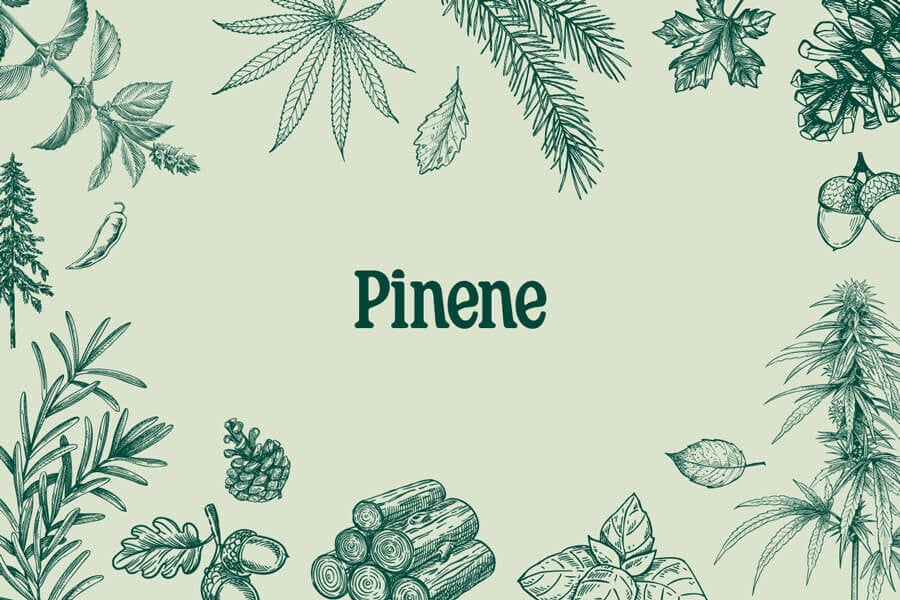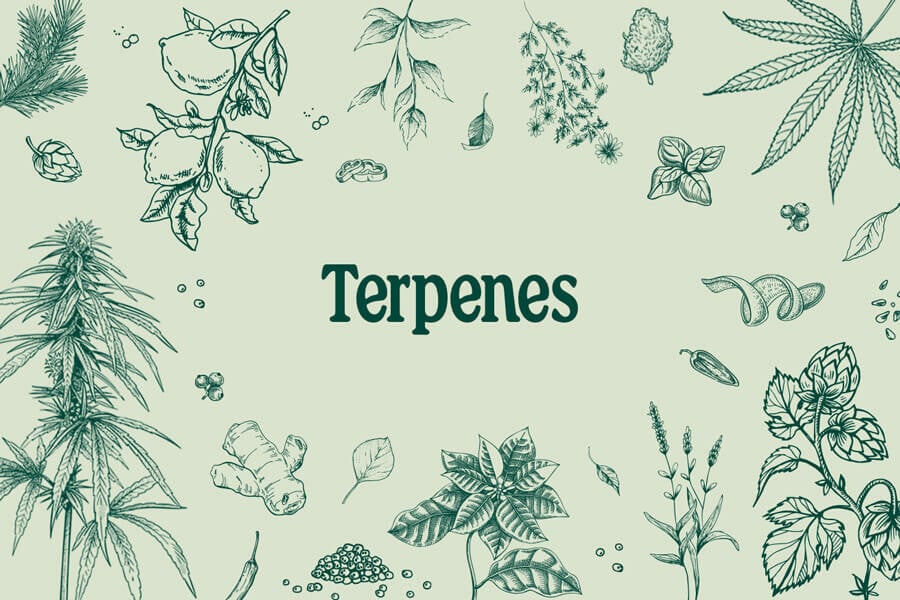.

These Plants and Fungi Also Contain Cannabinoids
Cannabis produces over 100 cannabinoids. Researchers once believed these molecules were exclusive to the herb, but it turns out many other plants (and fungi) produce cannabinoids too. Explore the long list of organisms that manufacture these molecules, and learn how they affect the endocannabinoid system.
Contents:
- What is a cannabinoid, exactly?
- Why do plants (and fungi) make cannabinoids?
- Coneflower (echinacea)
- Electric daisy (acmella oleracea)
- Woolly umbrella (helichrysum umbraculigerum)
- Liverwort (radula marginata)
- Black pepper (piper nigrum)
- Chocolate (theobroma cacao)
- Black truffles (tuber melanosporum)
- Chinese rhododendron (rhododendron sinogrande)
- Kava (piper methysticum)
- Carrots
- Brassica
- Cotton weed plant (otanthus maritimus)
- Maca (lepidium meyenii)
- Staff-vine family (celastraceae)
- Turmeric (curcuma longa)
- Hops (humulus lupulus)
- Tea plant (camellia sinensis)
- Rue (ruta graveolens)
- Magnolia officinalis
- Protium heptaphyllum b.
- Chillies
- Cordyceps annulata
- Turkey tail (trametes versicolor)
- Chaga (inonotus obliquus)
- Cannabinoids are everywhere
Cannabinoids. The very name of this chemical class makes it appear exclusive to cannabis. While it's true that researchers first identified cannabinoids in the controversial plant, their presence has since been detected in a growing list of other plant (and fungus) species. Some of these are common—you probably have them in your kitchen—whereas others are novel and exotic.
The cannabinoids THC and CBD are the superstars of the cannabis world. The former underpins the intoxicating, euphoric effects of cannabis, whereas the latter provides a clear-headed, non-intoxicating effect. Apart from the two main cannabinoids, cannabis produces over 100 other cannabinoids throughout its life cycle. Today, cannabis scientists are fairly familiar with the likes of CBG, CBC, and THCV, but they’re only just getting to grips with the rest of the gang.
What Is a Cannabinoid, Exactly?
The legendary cannabis scientist Dr Raphael Mechoulam—the man who discovered THC—first took a stab at defining cannabinoids back in 1979. He classified them, along with their carboxylic acids, as a group of compounds present in Cannabis sativa.[1]
Cannabinoids are defined as molecules that interact with the receptors of the endocannabinoid system (ECS).[2] Because the ECS regulates almost every physiological system to some degree, researchers are keen on studying molecules that can influence this extensive network.
The new definition of a cannabinoid has certainly broadened the hunt for chemicals of note, especially as a growing list of organisms are found to contain cannabinoids or cannabinoid-like substances.
A Word on Cannabimimetics
“Cannabimimetic” is a term that often pops up in scientific literature, referring to non-cannabis-derived molecules that mimic the effects of classical cannabinoids at ECS receptor sites. However, in accordance with recent definitions, many of these compounds do in fact satisfy the pharmacological definition of a cannabinoid. Yet, some cannabimimetics don’t interact with ECS receptors. Rather, they influence other components of the system, such as enzyme activity.
An example of this exists within cannabis too. While molecules such as THC, CBD, and CBG are classed as cannabinoids because of their molecular structure, an increasing number of cannabis-derived terpenes are now considered cannabinoids from a pharmacological point of view, despite having a different chemical makeup.
A 2021 study published in the journal Scientific Reports found the terpenes α-humulene, geraniol, linalool, and β-pinene to bind to the CB1 receptor—the same site where THC exerts its psychotropic effects.[3]
Why Do Plants (and Fungi) Make Cannabinoids?
The organisms that manufacture these compounds do so primarily to protect themselves. Cannabinoids autumn into a chemical category known as secondary metabolites.
Whereas primary metabolites are directly involved in the structure, growth, and reproduction of a plant, secondary metabolites are a botanical form of chemical warfare. These molecules are churned out to deter pests, put off grazing herbivores, and even protect the organism against UV rays.
Why, then, do they have such a specific effect on the human body? A fine question, indeed. Some lay these ridiculous odds at the feet of intelligent design, whereas others claim we evolved alongside cannabinoid-producing organisms.
Below, you’ll become familiar with an array of plant and fungus species that produce cannabinoids, or chemicals that otherwise influence the function of the ECS. Unsurprisingly, studies are presently investigating the clinical potential of many of these molecules. As such, you're likely to see these substances mentioned in greater frequency in the domains of medicine and cannabis in the near future.
Coneflower (Echinacea)
| Cannabinoid(s): Alkamides |
| Cannabinoid(s): Alkamides |
Known commonly as coneflowers, the nine species that make up the Echinacea genus are native to North America. The natives in this region used these plants for holistic purposes, and today, coneflowers are widely available in preparations such as teas, tinctures, and capsules. Researchers are focusing their efforts on understanding the principal active constituents of Echinacea, known as alkamides.
These substances closely resemble the chemical structures of endocannabinoids found in the human body, namely anandamide and 2-AG. Early studies have found alkamides to interact with the two major ECS receptors, cannabinoid receptor 1 (CB1) and cannabinoid receptor 2 (CB2).[4] Alkamides also demonstrate activity on peroxisome proliferator-activated receptors (PPARs), sites that make up the “expanded endocannabinoid system”.
Electric Daisy (Acmella oleracea)
| Cannabinoid(s): Spilanthol |
| Cannabinoid(s): Spilanthol |
This strange plant sends a jolt of electricity through the mouth. Seriously, these edible perennial flowers don’t just look beautiful; when chewed, they make the tongue tingle, making them a novel food item.
Cultures in Brazil and Argentina have traditionally used this flower to tackle toothache. Although comprehensive trials are required to provide evidence for this use, researchers have discovered that electric daisy produces a substance called spilanthol, which binds to the CB2 receptor.[5]
Although it doesn’t bind very effectively, it still displays some level of affinity. Because the CB2 receptor plays a significant role in the immune response, future studies could demonstrate that these traditional cultures were onto something.[6]
Woolly Umbrella (Helichrysum umbraculigerum)
| Cannabinoid(s): CBG/CBG analogue |
| Cannabinoid(s): CBG/CBG analogue |
Also known as woolly umbrella helichrysum, this fast-growing perennial develops sulphur-yellow flowers. These umbrella-like blooms are native to southern Africa, from the highlands of Zimbabwe to those of the Eastern Cape.
You won’t find THC in this brightly coloured species, or CBD for that matter. Instead, this plant produces a close cousin to CBG. Initial investigations claim to have found the exact same molecule within the plant, but further research failed to confirm this finding. However, a study conducted in 2018 found a phenethyl analogue of CBG, known as heli-CBG.[7]
Research into this species remains early, and scientists face tough restrictions and difficulty achieving samples. Much remains unknown, but some researchers believe woolly umbrella helichrysum possesses the molecular machinery to produce psychoactive cannabinoids.
Liverwort (Radula marginata)
| Cannabinoid(s): PET, CBGA analogues |
| Cannabinoid(s): PET, CBGA analogues |
Liverwort might seem like an unlikely place to find cannabinoids. This unassuming species, native to New Zealand, goes by the name wairuakohu and belongs to a division of plants called bryophytes. These specimens possess no roots or vascular tissues, and instead obtain water and nutrients through the air.
Maori healers in the region have traditionally used liverwort to benefit the liver and digestive system. Now, this humble species has garnered attention for its ability to churn out cannabinoids.
Research published in the journal Frontiers in Plant Science sequenced liverwort and detected genes involved in the biosynthesis of cannabinoids, as well as analogues of CBGA.[8] But the plant doesn’t just produce precursors to major cannabinoids. Further chemical investigations have discovered a psychoactive molecule that closely resembles THC—known as perrottetinene (PET)—which has led to a boom in internet sales of liverwort as a “legal high”.[9]
Black Pepper (Piper nigrum)
| Cannabinoid(s): Beta-Caryophyllene, guineensine |
| Cannabinoid(s): Beta-Caryophyllene, guineensine |
Sprinkling black pepper over stir-fry dishes and soups adds a pungent kick, but it also decorates food with cannabinoids! The spice contains a molecule known as beta-caryophyllene, which qualifies as both a terpene and a cannabinoid. Indeed, it’s one of the most abundant terpenes found in cannabis, and contributes flavour notes of spice and sweetness to many different strains.
Because the molecule also occurs in common herbs such as cloves, basil, and oregano, researchers refer to it as a dietary cannabinoid.[10] Beta-caryophyllene binds to the CB2 with potency, and ongoing studies are exploring the potential of the chemical in managing inflammation, accelerating fracture healing, and even tackling anxiety and depression through this mechanism.
Dietary cannabinoids aside, black pepper also contains a molecule that influences endocannabinoid levels. The compound guineensine inhibits the uptake of anandamide and temporarily increases circulating levels.[11] Future studies will explore the potential role of this substance in benefiting cases of clinical endocannabinoid deficiency and other conditions.
Chocolate (Theobroma cacao)
| Cannabinoid(s): Anandamide/anandamide reuptake inhibitors |
| Cannabinoid(s): Anandamide/anandamide reuptake inhibitors |
Chocolate literally grows on trees. That’s right, before appearing in bright packaging on supermarket shelves, chocolate starts life as cacao beans—the dried and fermented seeds of cacao fruit pods.
Native to the Amazon, chocolate has a long and rich history; the Mayans used it in spiritual ceremonies, and the Aztec emperor Moctezuma II drank cacao beverages from a golden goblet. These days, people mainly snack on chocolate as a pick-me-up. But why does this pleasant snack make us feel so good? Well, chocolate is thought to contain the endocannabinoid anandamide.
Much like THC, anandamide binds to the CB1 receptor, where it has a positive impact on mood. Internal anandamide levels also surge during exercise. If you’ve ever experienced the euphoria of the “runner’s high”, you’ll know just how good anandamide can make you feel![12]
However, some researchers aren’t sold on the idea of anandamide itself in chocolate, instead suggesting that molecules within the foodstuff inhibit enzymes that drive natural levels of anandamide.
Black Truffles (Tuber melanosporum)
| Cannabinoid(s): Anandamide |
| Cannabinoid(s): Anandamide |
Black truffles are magic mushrooms in their own right, but they don’t contain psilocybin. Instead, these ground-dwelling sclerotia contain the “bliss molecule” anandamide. Researchers discovered that these prized culinary fungi have the genetic equipment necessary to manufacture endocannabinoids—enzymes and all.
However, they lack the traditional endocannabinoid receptors found in a multitude of animal species.[13] Instead of using these molecules to light up conventional ECS receptors, it turns out truffles rely on endocannabinoids to make the melanin that forms their black exterior.
The presence of anandamide in black truffles raises the question: Why is it that people are willing to pay so much for this delectable food item? At a costly price of €1,500/kg, it makes sense that we get a lot more than just taste from these meaty clumps of mycelium.
Chinese Rhododendron (Rhododendron sinogrande)
| Cannabinoid(s): Anthopogocyclolic acid, anthopogochromenic acid, meroterpenes, etc. |
| Cannabinoid(s): Anthopogocyclolic acid, anthopogochromenic acid, meroterpenes, etc. |
This evergreen shrub sits comfortably at altitudes of 3,000m above southwestern China and northeastern Myanmar, where it reaches heights of 10m and blooms large trusses of cream-yellow flowers. Although largely recognised as an ornamental piece in gardens, this species produces an array of molecules that researchers are fawning over.
Back in 2011, scientists in Japan discovered two cannabinoid-like substances in the plant, known as anthopogocyclolic acid and anthopogochromenic acid. On top of this, they also found five cannabinoid analogues, including a CBC type, CBL type, and CBT type.[14] But the phytochemical complexity doesn’t end there. Another probe into this species during 2020 unveiled an additional 20 meroterpenes that researchers are currently testing for anti-inflammatory properties.[15]
Future studies will hopefully discover how these components impact the ECS, and if any synergy exists between them.
Kava (Piper methysticum)
| Cannabinoid(s): Kavalactones (yangonin) |
| Cannabinoid(s): Kavalactones (yangonin) |
Human cultures are diverse. But a common thread runs between them: the use of plans to alter consciousness. Native occupants of islands scattered throughout the Pacific Ocean—including Tonga, Fiji, and Vanuatu—use kava for this purpose.
Today, people still frequent dedicated kava bars to neck bowlfuls of preparations made from the plant. The roots contain a group of active constituents known as kavalactones, which impart euphoric and sleepy sensations that lubricate the social cogs. Studies are presently exploring the effects of these molecules on mental maladies such as anxiety.[16] These effects aren’t dissimilar to those of cannabis, and the kavalactone yangonin binds to the CB1 receptor; the same site THC activates to produce a high.[17]
Carrots
| Cannabinoid(s): Falcarinol |
| Cannabinoid(s): Falcarinol |
The humble carrot. You’ve eaten hundreds of these root vegetables in your lifetime—stewed, steamed, roasted, and fresh. While you’re probably aware of the benefits of their carotene content, chances are you didn’t realise you were chomping down on cannabinoids with every bite.
That’s right! Carrots contain a cannabinoid by the name of falcarinol, which binds to the CB1 receptor.[17] Unlike agonists such as THC, falcarinol acts as an antagonist at this site, meaning it temporarily blocks other ligands from binding to the receptor. Researchers are currently exploring the role of CB1 antagonists in conditions such as obesity. While the carrot-based cannabinoid poses promise in this area, its pro-allergic properties are a big stumbling block.
Brassica
| Cannabinoid(s): DIM |
| Cannabinoid(s): DIM |
The Brassica genus includes broccoli, cauliflower, turnip, kohlrabi, cabbage, and many other plants. Interestingly, these delicious vegetables all stem from the same plant; we have selective breeding to thank for this diversity.
Adding a portion of Brassica vegetables to your plate comes with the benefits of vitamins, minerals, and potent antioxidants. But this family of vegetables also contains a cannabinoid that is widespread throughout the genus. The dietary indole DIM works as a partial agonist of the CB2 receptor, and ongoing trials are testing the molecule for antitumour, antiviral, antibacterial, and immunomodulatory potential.[18]
Cotton Weed Plant (Otanthus maritimus)
| Cannabinoid(s): Alkylamides |
| Cannabinoid(s): Alkylamides |
This aromatic perennial herb belongs to the daisy family and favours the warm and dry climates of the Mediterranean, where it roots into the sand. It plays an important ecological role by stabilising dunes over time.
Traditional cultures in the region used the cotton weed plant as a holistic herb to soothe the body and boost the immune system. Intrigued by its historical use, modern research has uncovered terpenes, flavonoids, and cannabinoids during phytochemical investigations of the plant. Extracts from the plant contain several compounds of interest, particularly alkylamides, that bind to both CB1 and CB2 receptors.[19] Further studies are required to understand the relevance of these findings in humans.
Maca (Lepidium meyenii)
| Cannabinoid(s): Macamides |
| Cannabinoid(s): Macamides |
If you’ve ever walked through the doors of a health food shop, you’ll have come across the word “maca”. Also known as Peruvian ginseng, this Andean tuber has surged in popularity over recent years as a superfood; packed full of vitamins, minerals, and polyphenols, it certainly deserves the title.
Adding maca to the diet doesn’t just provide the body with a wealth of key nutrients—the food also packs alkylamides, which modulate the ECS. Maca doesn’t contain molecules that bind to ECS receptors directly. Instead, these long-chain fatty acids, called macamides, are able to inhibit anandamide-degrading enzymes, enabling the body to get high off its own supply.[20]
Staff-Vine Family (Celastraceae)
| Cannabinoid(s): Pristimerin |
| Cannabinoid(s): Pristimerin |
The staff-vine family of plants, or the Celastraceae, contains over 1,300 species of herbs, vines, and trees found mainly within tropical climates. Many members of this family produce a secondary metabolite that interfaces with the ECS.
The terpene pristimerin interferes with the activity of an enzyme called monoacylglycerol lipase, remembered more easily as MAGL.[21] This protein works to break down the endocannabinoid 2-AG, a ligand tasked with regulating myriad physiological functions, including appetite, immune function, and pain management. Much like FAAH inhibitors show potential in cases of endocannabinoid deficiency, pristimerin offers a potential means of boosting anandamide’s biological counterpart, 2-AG.
Turmeric (Curcuma longa)
| Cannabinoid(s): Curcumin |
| Cannabinoid(s): Curcumin |
This colourful spice and member of the ginger family maintains a revered status in several cultures. It has a special place in both Ayurveda and traditional Chinese holistic practices, and recent studies have examined the anti-inflammatory potential of this vibrant rhizome. Some studies are even investigating using cannabis and turmeric as a two-pronged treatment for digestive diseases.[22]
Many of turmeric’s benefits stem from the constituent curcumin, a polyphenol that interacts with the endocannabinoid system. This molecule binds to CB1 and CB2 receptors, and increases endocannabinoid levels in the brain. Studies also show that curcumin upregulates CB2 expression and downregulates CB1, a mechanism being explored for its usefulness in liver fibrosis.[23]
Hops (Humulus lupulus)
| Cannabinoid(s): Beta-Caryophyllene, myrcene, humulene, other tepernes |
| Cannabinoid(s): Beta-Caryophyllene, myrcene, humulene, other tepernes |
Hops and cannabis have some striking similarities. For one, they both belong to the 170-species-strong family Cannabaceae. Both also possess glandular trichomes that churn out high levels of aromatic terpenes. Craft beer brewers harness the pungency of hops to infuse their creations with these volatile molecules. While hops don’t contain traditional cannabinoids, they do produce the CB2 agonist beta-caryophyllene, along with other terpenes found in cannabis, such as myrcene and humulene.
Tea Plant (Camellia sinensis)
| Cannabinoid(s): Catechins |
| Cannabinoid(s): Catechins |
Everyone loves a soul-warming cup of tea. We often brew a cup when we’re in the mood for a small dose of caffeine and the sweetness of a teaspoon or two of sugar. But sipping on tea supplies the body with antioxidants and molecules that strengthen the bones and support heart health.
Catechins are one of the superstar constituents in the tea plant. As well as boasting immune-boosting and neuroprotective potential, these molecules bind to ECS receptors, particularly those situated in the central nervous system.[24]
Rue (Ruta graveolens)
| Cannabinoid(s): Rutamarin |
| Cannabinoid(s): Rutamarin |
Also known by the common name "rue"—and the much fancier "herb of grace"—Ruta graveolens is an ornamental plant species native to the Balkan Peninsula. The plant has a history of culinary use, and medieval physicians used the herb to sharpen eyesight and dissipate flatulence.
In the hunt for phytocannabinoids, researchers discovered the presence of rutamarin in the species. Experiments show that this derivative of the chemical coumarin binds to the CB2 receptor, suggesting a potential role in the future of cannabinoid therapeutics.[25]
Magnolia officinalis
| Cannabinoid(s): Magnolol, honokiol, trans-isomagnolol |
| Cannabinoid(s): Magnolol, honokiol, trans-isomagnolol |
This large deciduous tree—currently endangered—stems from the mountains and valleys of China. Traditional Chinese practitioners use the bark of this species to alleviate phlegm and promote sleep. Upon analysing extracts made from the tree, modern researchers have discovered that it contains several cannabinoids.[26]
The molecule magnolol behaves as a particle CB2 agonist, meaning it only slightly activates the site. In contrast, the constituent honokiol fully activates the CB1 receptor. Another chemical present in the tree, known as trans-isomagnolol, activates a site called GPR55, a candidate for the designation of the CB3 receptor.
Protium heptaphyllum B.
| Cannabinoid(s): β-Amyrin |
| Cannabinoid(s): β-Amyrin |
A member of the Burseraceae family, this tree produces an aromatic resin loaded with pharmacologically active molecules. Traditionally used to soothe the body, modern analysis has detected the triterpene β-amyrin within this sticky substance. This chemical occurs in a range of plants and fungi, and interfaces with the ECS. The metabolite works as an antagonist of the CB1 receptor while also inhibiting MAGL, suggesting it helps to temporarily boost 2-AG levels.[19]
Chillies
| Cannabinoid(s): Capsaicin |
| Cannabinoid(s): Capsaicin |
Do you like your food spicy? Every time you dig into a chilli-infused meal, you can thank the molecule capsaicin for the heat that you experience. This chemical binds to a receptor called transient receptor potential cation channel subfamily V member 1 (TRPV1) to produce this effect.
But this receptor does more than detect heat; it’s involved in pain signalling and immune cell function. Cannabinoids such as CBD and the endocannabinoid anandamide also bind to this site, leading some researchers to label TRPV1 as the third cannabinoid receptor, a designation that would make capsaicin meet the definition of a cannabinoid.[27]
Cordyceps annulata
| Cannabinoid(s): Annulatins |
| Cannabinoid(s): Annulatins |
As demonstrated by black truffles, cannabinoids aren’t confined to the plant kingdom. Fungi are a distinct kingdom of their own; they’re genetically closer to animals than they are to plants. The Cordyceps genus isn’t only unusual in the world of fungi; it’s a display of Mother Nature at her freakiest.
The spores of this genus infect a variety of insects, take over their bodies with a mycelium network, and send fruiting bodies bursting out to disperse more spores. Cordyceps mushrooms have a long history of use and are prized in Chinese holistic practices. One member of the genus—Cordyceps annulata—produces dihydrobenzofurans known as annulatins, which bind to the CB1 and CB2 receptors.[28]
Turkey Tail (Trametes versicolor)
| Cannabinoid(s): PSP |
| Cannabinoid(s): PSP |
This common fungus rots the decaying wood of over 70 tree species and grows in a shelf-like formation; its characteristic concentric circles and smooth, white pore surface makes it easy to spot. Although seemingly unremarkable upon first sight, these fungal powerhouses contain polysaccharides (complex carbohydrates) currently used as an adjuvant cancer therapy in Japan. One such polysaccharide goes by the name of polysaccharopeptide (PSP), and binds to CB2 receptors. Researchers are exploring if this mechanism might help to alleviate pain and inflammation.[29]
Chaga (Inonotus obliquus)
| Cannabinoid(s): Betulinic acid |
| Cannabinoid(s): Betulinic acid |
Chaga mushrooms are a life form steeped in mystery. Foragers delight when they come across this rare species, and many follow in the footsteps of the Khanty people of Siberia by decocting it into a tea.
Known as the “king of the medicinal mushrooms”, it’s not technically a mushroom. Rather, it forms a dense, black mass on the side of host trees known as a sclerotium. Chaga contains an array of intriguing compounds, including betulinic acid, a triterpene that interacts with CB1 and CB2 receptors.[30] Currently, researchers are exploring the anti-inflammatory, antioxidant, and immunomodulatory potential of this chemical.
Cannabinoids Are Everywhere
Cannabinoids are by no means exclusive to the cannabis plant. Although scientific investigation of the herb led to the discovery of these molecules, these findings have simply paved the way for a much broader and more in-depth conversation.
Cannabinoids underpin the unique effects of many plant and fungus species, and researchers have only scratched the surface of this biological treasure trove. In the coming years, we’re likely to see many other organisms join the pantheon of cannabinoid-containing life forms.
- Cannabinoids: Definitional ambiguities and a proposal https://doi.org
- A closer look at cannabimimetic terpenes, polyphenols, and flavonoids: a promising road forward https://www.ncbi.nlm.nih.gov
- Cannabis sativa terpenes are cannabimimetic and selectively enhance cannabinoid activity https://www.nature.com
- Beyond Cannabis: Plants and the Endocannabinoid System https://pubmed.ncbi.nlm.nih.gov
- Exploration of natural alkylamides and synthetic analogs as source for new ligands for the cannabinoid type-2 receptor https://www.researchgate.net
- The Cannabinoid CB2 Receptor as a Target for Inflammation-Dependent Neurodegeneration https://www.ncbi.nlm.nih.gov
- Amorfrutin-type phytocannabinoids from Helichrysum umbraculigerum https://pubmed.ncbi.nlm.nih.gov
- Identification of Putative Precursor Genes for the Biosynthesis of Cannabinoid-Like Compound in Radula marginata https://www.frontiersin.org
- Uncovering the psychoactivity of a cannabinoid from liverworts associated with a legal high https://www.science.org
- Beta-caryophyllene is a dietary cannabinoid https://www.pnas.org
- An Endocannabinoid Uptake Inhibitor from Black Pepper Exerts Pronounced Anti-Inflammatory Effects in Mice https://pubmed.ncbi.nlm.nih.gov
- A runner’s high depends on cannabinoid receptors in mice https://www.pnas.org
- Truffles contain endocannabinoid metabolic enzymes and anandamide https://pubmed.ncbi.nlm.nih.gov
- New cannabinoid-like chromane and chromene derivatives from Rhododendron anthopogonoides https://pubmed.ncbi.nlm.nih.gov
- Meroterpenoids with diverse structures and anti-inflammatory activities from Rhododendron anthopogonoides https://www.sciencedirect.com
- Kava extract versus placebo for treating anxiety https://www.ncbi.nlm.nih.gov
- Kavalactones and the endocannabinoid system: the plant-derived yangonin is a novel CB₁ receptor ligand https://pubmed.ncbi.nlm.nih.gov
- Lipid G protein-coupled receptor ligand identification using beta-arrestin PathHunter assay https://pubmed.ncbi.nlm.nih.gov
- An overview on plants cannabinoids endorsed with cardiovascular effects https://www.sciencedirect.com
- Macamides and their synthetic analogs: Evaluation of in vitro FAAH inhibition https://www.researchgate.net
- Discovery of Potent and Reversible Monoacylglycerol Lipase Inhibitors https://www.ncbi.nlm.nih.gov
- Cannabis and Turmeric as Complementary Treatments for IBD and Other Digestive Diseases https://pubmed.ncbi.nlm.nih.gov
- Small Molecules from Nature Targeting G-Protein Coupled Cannabinoid Receptors: Potential Leads for Drug Discovery and Development https://pubmed.ncbi.nlm.nih.gov
- Tea catechins' affinity for human cannabinoid receptors https://pubmed.ncbi.nlm.nih.gov
- Phytocannabinoids beyond the Cannabis plant – do they exist? https://www.ncbi.nlm.nih.gov
- Magnolia Extract, Magnolol, and Metabolites: Activation of Cannabinoid CB2 Receptors and Blockade of the Related GPR55 https://www.ncbi.nlm.nih.gov
- Endocannabinoid System Components: Overview and Tissue Distribution https://pubmed.ncbi.nlm.nih.gov
- Dihydrobenzofurans as cannabinoid receptor ligands from Cordyceps annullata, an entomopathogenic fungus cultivated in the presence of an HDAC inhibitor https://www.researchgate.net
- Polysaccharopeptide from Trametes versicolor blocks inflammatory osteoarthritis pain-morphine tolerance effects via activating cannabinoid type 2 receptor https://pubmed.ncbi.nlm.nih.gov
- Betulinic Acid Targets YY1 and ErbB2 through Cannabinoid Receptor-Dependent Disruption of MicroRNA-27a:ZBTB10 in Breast Cancer https://www.ncbi.nlm.nih.gov






































